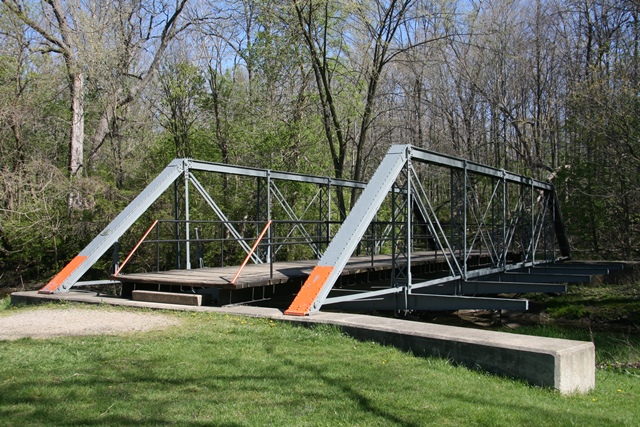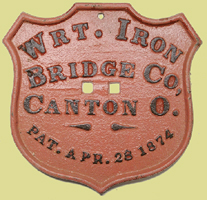We Recommend:
Bach Steel - Experts at historic truss bridge restoration.
BridgeHunter.com Phase 1 is released to the public! - Visit Now
Island Park Bridge
Church Street Bridge

Primary Photographer(s): Nathan Holth and Rick McOmber
Bridge Documented: Fall/Winter 2006, April 6, 2012, and June 19, 2012
Adrian: Lenawee County, Michigan: United States
By Builder/Contractor: Wrought Iron Bridge Company of Canton, Ohio
Not Available or Not Applicable
Not Available
Not Available
Not Available
1 Main Span(s)
Not Applicable

View Information About HSR Ratings
Bridge Documentation

This bridge is a large pony truss that has been moved two times. Keith Dersham, engineer for the City of Adrian, provided the following history:
It was originally on Church Street in Adrian and was disassembled by the WPA in the 1930's when a new bridge was built. It was kept in storage a few years until the park was developed and was then installed as the entrance means to the park. When traffic became too high for the bridge to safely handle it was taken out of service when a culvert was installed adjacent. It was later moved to its present location in the early 1980's by the Lenawee County Road Commission using money donated by the Jaycees.
This bridge features fascinating floor beam design. The bridge once carried sidewalks on either side. Decorative posts from what must have been impressive sidewalk railings still remain. Rather than sitting on cantilevered brackets separate of the floor beams, the sidewalks sit on the floor beam itself, which was extended beyond the truss lines. The floor beams are built-up beams, and are shape such that they start at the center of the bridge quite deep, and get increasingly shallow, terminating at the sidewalk railing posts. The ends of the floor beams are capped with a decorative piece of iron with a star-like design on it. The beams look a bit odd with no sidewalk on them, but it is easy to see the engineering behind the design. This was a fancy bridge when it was built, and is so still. It is undoubtedly one of Michigan's most historically and technologically important pony truss bridges.
At the time of documentation, this bridge was one of the few truss bridges in Michigan that retained a builder plaque. By 2010 however, the plaque had been stolen. Removal of bridge plaques without express authorization from the owner of the bridge is theft and HistoricBridges.org will report any observations and findings relating to plaque theft to the authorities.
The plaque that was located on the bridge read Pat. Apr. 28, 1874. This however refers to the patent date, and likely does not reflect the construction date. As such, the construction date is not known. The Wrought Iron Bridge Company was notorious for not listing construction dates on their plaques. Also, the patent might not have been for the exact design of the bridge. The construction details on the Island Park Bridge date stylistically to a late 1870s or early 1880s truss bridge. The plaque on the Island Park Bridge is hard to read. The image of a plaque shown on this page, taken from Douglas Coulter's page of stolen bridge plaques more clearly shows what the Island Park Bridge plaque says.
Today, the bridge has a narrow non-original deck for pedestrians on it, and appears to serve some sort of park trail that runs through the woods. The roller bearing nest was retained when the bridge was moved. The nest was apparently cleaned, and is in good condition offering a clear look at a structural part that is usually caked with accumulations of dirt. Be sure to look at it if you visit the bridge. See the photo gallery for a picture in the full/wallpaper section of the bearing. Although the bridge was relocated in the 80s, the bridge received little other attention for many years, and was in need of a fresh coat of paint.
This is a rare historic bridge that few people seem to be aware of. It is a must-see for any historic bridge enthusiast that is in the area!
Dalon Wicking repainted this bridge as part of a boy scout project in 2010. Some of the weeds and such that had overgrown the bridge were also removed. Wicking did the work alongside 20 other people. These efforts have greatly improved the appearance and condition of the bridge and this project is a great example of members of a local community showing support and appreciation for the historic bridge.
If the stolen plaque cannot be found, it would be nice to see a replica plaque put on the bridge (more securely) to make this bridge complete again. The plaque is a standard type (and doesn't even have a construction date, so they all are identical) used by the Wrought Iron Bridge Company and a pattern for replica casting could be made from the plaque of another bridge.
This bridge is tagged with the following special condition(s): Unorganized Photos
![]()
Photo Galleries and Videos: Island Park Bridge
Bridge Photo-Documentation
A collection of overview and detail photos. This photo gallery contains a combination of Original Size photos and Mobile Optimized photos in a touch-friendly popup viewer.Alternatively, Browse Without Using Viewer
![]()
Additional Unorganized Photos
Original / Full Size PhotosA supplemental collection of photos that are from additional visit(s) to the bridge and have not been organized or captioned. This gallery offers photos in the highest available resolution and file size in a touch-friendly popup viewer.
Alternatively, Browse Without Using Viewer
![]()
Additional Unorganized Photos
Mobile Optimized PhotosA supplemental collection of photos that are from additional visit(s) to the bridge and have not been organized or captioned. This gallery features data-friendly, fast-loading photos in a touch-friendly popup viewer.
Alternatively, Browse Without Using Viewer
![]()
Maps and Links: Island Park Bridge
Coordinates (Latitude, Longitude):
Search For Additional Bridge Listings:
Bridgehunter.com: View listed bridges within 0.5 miles (0.8 kilometers) of this bridge.
Bridgehunter.com: View listed bridges within 10 miles (16 kilometers) of this bridge.
Additional Maps:
Google Streetview (If Available)
GeoHack (Additional Links and Coordinates)
Apple Maps (Via DuckDuckGo Search)
Apple Maps (Apple devices only)
Android: Open Location In Your Map or GPS App
Flickr Gallery (Find Nearby Photos)
Wikimedia Commons (Find Nearby Photos)
Directions Via Sygic For Android
Directions Via Sygic For iOS and Android Dolphin Browser
USGS National Map (United States Only)
Historical USGS Topo Maps (United States Only)
Historic Aerials (United States Only)
CalTopo Maps (United States Only)


